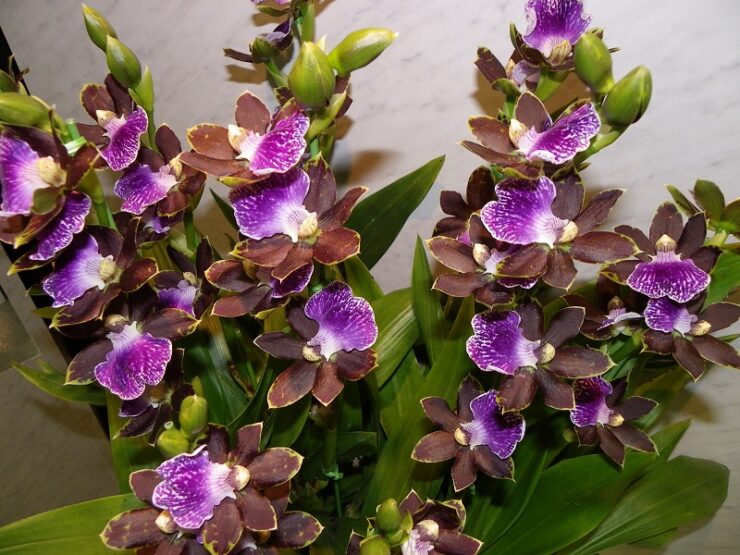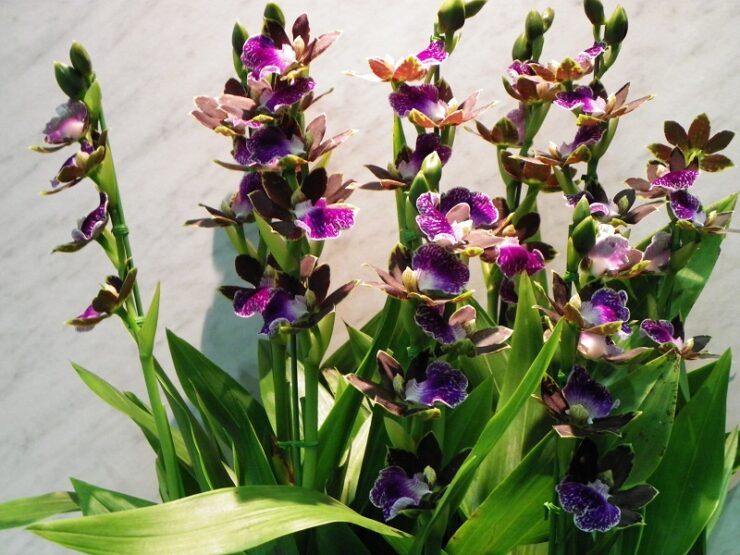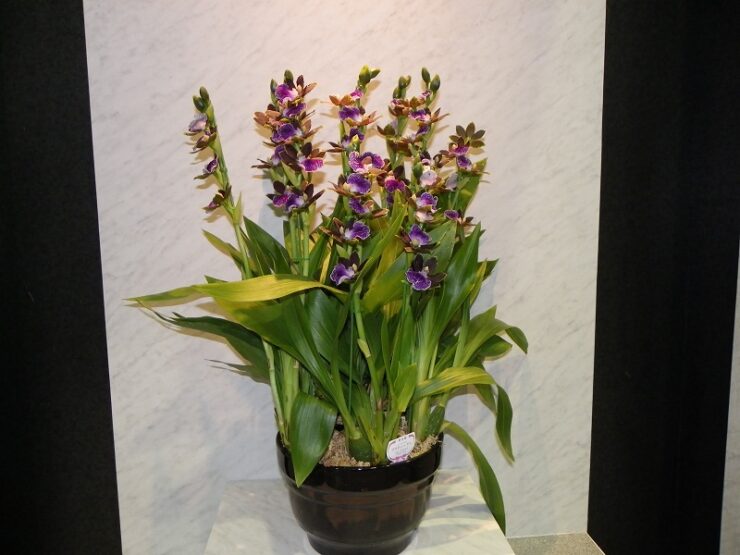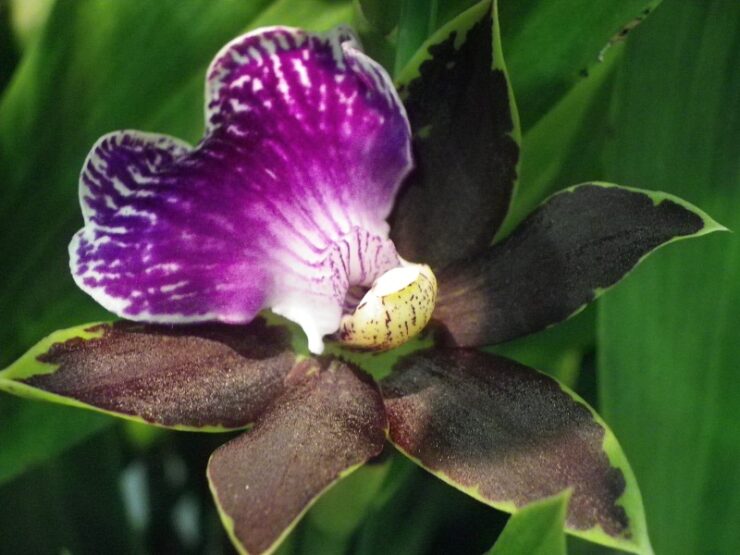In this article, we will explore the captivating allure and significance of the March birth orchid, known as the Zygopetalum, which holds a special place in the world of flowers and is highly regarded for its breathtaking appearance and rich cultural symbolism.
The Zygopetalum is a favorite choice among orchid enthusiasts due to its elegant, yet bold appearance, with petals that come in a range of colors including green, brown, purple, and even vibrant shades of blue.
Beyond its beauty, this orchid also carries cultural significance in various parts of the world. Some cultures believe it symbolizes strength, wisdom, and beauty, while others consider it a symbol of harmony and balance, reflecting the orchid’s ability to thrive in diverse environments.
As we delve deeper into the March birth-orchid, we will uncover the various meanings and traditions associated with this extraordinary flower.
History of the Orchid Zygopetalum

The history of the Zygopetalum orchid can be traced back to the early 19th century when these captivating flowers were first discovered in the tropical regions of South America.
The name “Zygopetalum” is derived from the Greek words “zygon,” meaning yoke, and “petalon,” meaning petal, referring to the unique, yoke-like structure of its petals.
The first documented discovery of the Zygopetalum orchid dates back to 1827 when the species Zygopetalum Mackay was found by the British botanist and explorer John Lindley in Brazil.
Since then, more than 20 species of Zygopetalum have been identified, primarily in countries such as Brazil, Peru, Colombia, Bolivia, and Ecuador.
They are usually found in humid montane forests, thriving in high-altitude environments with ample moisture and cool temperatures.
Throughout the 19th and early 20th centuries, Zygopetalum orchids were brought back to Europe by plant collectors, who were captivated by their striking colors and intricate patterns.
These orchids soon became popular in Victorian-era Europe, where they were cultivated and appreciated for their exotic beauty and captivating fragrance.
They were particularly favored by wealthy collectors who would display them in their opulent glasshouses and conservatories.
Today, Zygopetalum orchids continue to captivate orchid enthusiasts around the world. Advances in breeding and cultivation techniques have led to the development of numerous hybrid varieties, showcasing even more stunning colors and patterns.
These orchids are now grown and enjoyed by hobbyists and professional growers alike for their impressive blooms, unique fragrance, and relative ease of cultivation compared to some other orchid genera.
Symbolism and Cultural Significance

The Zygopetalum orchid, with its striking appearance and captivating fragrance, has come to symbolize various attributes and qualities across different cultures. Its symbolism and cultural significance are deeply rooted in the unique characteristics that make this orchid stand out among other flowers.
Strength and Resilience:
Zygopetalum orchids are known for their ability to thrive in diverse environments, from high-altitude montane forests to the controlled conditions of a hobbyist’s greenhouse. This adaptability has led to the association of Zygopetalum with strength and resilience, representing the capacity to endure challenges and adapt to changing circumstances.
Harmony and Balance:
The intricate patterns and vibrant colors found on Zygopetalum petals create a sense of harmony and balance. This symbolism can be extended to various aspects of life, such as relationships, work, and personal growth, emphasizing the importance of finding equilibrium and stability in one’s endeavors.
Beauty and Elegance:
The striking appearance of Zygopetalum orchids, with their bold colors and delicate patterns, is a testament to their inherent beauty and elegance. They have been cherished by flower enthusiasts for centuries and are often seen as symbols of refinement, sophistication, and grace.
Sensuality and Passion:
The alluring fragrance of Zygopetalum orchids, which can range from sweet and floral to spicy and musky, has also contributed to their cultural significance. The intoxicating scent is often associated with sensuality and passion, evoking feelings of attraction and desire.
Medicinal Purposes
While the Zygopetalum orchid is primarily known for its ornamental beauty, orchids, in general, have been used for medicinal purposes in various cultures throughout history. However, it is important to note that the use of Zygopetalum specifically for medicinal purposes is not well-documented and should be approached with caution.
Orchids have been used in traditional medicine, particularly in Chinese and Ayurvedic practices, to treat a variety of ailments. Some commonly used orchid species in these traditions include Dendrobium, Cymbidium, and Bletilla. The medicinal properties attributed to orchids may include:
- Antioxidant properties: Some orchids contain compounds that have antioxidant properties, which can help protect cells from damage caused by free radicals and may contribute to overall health.
- Immune system support: Certain orchid species have been used to boost the immune system, helping the body to fend off infections and illnesses.
- Anti-inflammatory properties: Some orchids have been used to treat inflammation and swelling, providing relief for conditions like arthritis and other inflammatory disorders.
- Aphrodisiac properties: Orchids have also been used as aphrodisiacs in traditional medicine, believed to improve sexual health and vitality.
- Digestive health: Some orchid species have been used to treat digestive issues, such as constipation, diarrhea, and indigestion.
Fun Facts

Here are some fun facts about the Zygopetalum orchid that showcase its unique qualities and intriguing characteristics:
Unique Fragrance:
Zygopetalum orchids are known for their captivating fragrance, which can range from sweet and floral to spicy and musky. The scent is often most pronounced in the early morning and late afternoon, adding to the allure of these captivating flowers.
Wide Range of Colors:
The Zygopetalum orchid boasts an impressive array of colors, including green, brown, purple, and even vibrant shades of blue. The flowers often feature intricate patterns and contrasting colors, making them a true visual delight.
Adaptability:
Zygopetalum orchids are native to the montane forests of South America, where they thrive in high-altitude environments with ample moisture and cool temperatures. Despite their tropical origins, these orchids can be successfully grown in controlled environments, such as greenhouses and indoor settings, demonstrating their remarkable adaptability.
Long-lasting Blooms:
They are appreciated not only for their beauty but also for their long-lasting blooms. The flowers can last for several weeks, providing a stunning display of color and fragrance that outlasts many other orchid species.
Hybrid Varieties:
Due to their popularity among orchid enthusiasts, Zygopetalum orchids have been extensively hybridized to produce a wide range of cultivars with diverse colors, patterns, and fragrances. This has expanded the availability and appeal of these orchids to an even broader audience.
Pollination Strategy:
Like many other orchids, they have developed unique pollination strategies to ensure their reproduction. Some Zygopetalum species rely on fragrance to attract pollinators, while others utilize specialized structures to mimic the appearance of female insects, tricking male insects into attempting to mate with the flower and thus facilitating pollination.
Care
Caring for a Zygopetalum orchid can be a rewarding experience, as these beautiful flowers can thrive under the right conditions. Here are some essential care tips to help you successfully cultivate and maintain your Zygopetalum orchid:
Light:
Zygopetalum orchids prefer bright, indirect light. Placing them near an east or west-facing window is ideal. Avoid exposing them to direct sunlight, as this can cause leaf scorching or damage to the flowers. If necessary, you can use artificial light sources, such as LED grow lights, to supplement natural light.
Temperature:
These orchids generally prefer intermediate temperatures, with daytime temperatures ranging from 65°F to 75°F (18°C to 24°C) and nighttime temperatures around 55°F to 60°F (13°C to 15°C). It is essential to maintain a consistent temperature range, as drastic fluctuations can stress the plant and inhibit blooming.
Humidity:
Zygopetalum orchids thrive in humid environments. Aim for a relative humidity level of 50% to 70%. You can increase humidity by placing the orchid on a tray filled with water and pebbles, using a humidifier, or misting the plant regularly. However, avoid wetting the flowers, as this can lead to rot.
Watering:
Water your Zygopetalum orchid regularly, ensuring the growing medium remains evenly moist but not soggy. Overwatering can lead to root rot, while underwatering can cause the pseudobulbs to shrivel. A good rule of thumb is to water once a week in the winter and twice a week in the summer, adjusting as needed based on your specific environment.
Growing Medium:
Zygopetalum orchids prefer well-draining growing media, such as a mix of fine-grade bark, perlite, and sphagnum moss. Repot your orchid every 2 to 3 years, or when the growing medium begins to break down and lose its drainage capabilities.
Fertilizing:
Feed your Zygopetalum orchid with a balanced orchid fertilizer every two weeks during the growing season (spring and summer) and once a month during the dormant season (fall and winter). Dilute the fertilizer to half the recommended strength to avoid overfeeding and root damage.
Pruning:
After your Zygopetalum orchid has finished blooming, carefully remove the spent flower spike at its base. This will encourage new growth and future blooms.
FAQ
How do I know when it’s time to repot my Zygopetalum orchid?
It’s time to repot your Zygopetalum orchid when the growing medium begins to break down and lose its drainage capabilities, usually every 2 to 3 years. Other signs that it’s time to repot include overcrowded roots, yellowing leaves, or a decline in overall plant health. Repotting is best done in the spring, just after the orchid has finished blooming.
How do I choose the right pot for my Zygopetalum orchid?
Select a pot that provides proper drainage and is slightly larger than the current root system. Orchids generally prefer snug pots, so avoid choosing a container that is significantly larger than the root ball. Many orchid enthusiasts prefer using clear plastic pots, as they allow for easy monitoring of the roots and moisture levels.
Alternatively, you can use clay or ceramic pots, which offer better airflow and stability for larger plants.
Are there any common pests or diseases that affect Zygopetalum orchids?
Zygopetalum orchids can be affected by common orchid pests, such as mealybugs, spider mites, and scale insects. These pests can be managed by using insecticidal soap, neem oil, or other suitable treatments.
Additionally, fungal and bacterial diseases, such as black rot and root rot, can occur due to overwatering or poor air circulation. To prevent these diseases, ensure that you provide proper air circulation, avoid overwatering, and maintain a clean growing environment.
What is the best way to propagate Zygopetalum orchids?
Zygopetalum orchids can be propagated through division, which is the process of separating a mature plant into smaller sections, each with its own root system and pseudobulbs. This method is typically done during repotting.
To divide your Zygopetalum orchid, carefully remove the plant from its pot, gently separate the root ball into smaller sections, and repot each section into its own container with fresh growing medium.
How do I encourage my Zygopetalum orchid to bloom more frequently?
Ensuring proper care and growing conditions is the key to promoting more frequent blooming in your Zygopetalum orchid. Pay close attention to lighting, temperature, watering, and fertilizing requirements, and adjust your care routine as needed.
Additionally, providing a slight drop in nighttime temperatures (about 10°F or 5°C) for a few weeks before the expected blooming period can help stimulate flower production.
Conclusion
Caring for a Zygopetalum orchid can be a delightful and fulfilling experience for both novice and experienced growers. By understanding the unique requirements and characteristics of these captivating flowers, you can create an optimal environment that promotes healthy growth and stunning, long-lasting blooms.
Whether you’re seeking to enrich your living space with their vibrant colors and captivating fragrance or want to explore the rich cultural symbolism of these orchids, the Zygopetalum is an excellent addition to any collection.
If you like this article read more here about November and August birth orchids.
